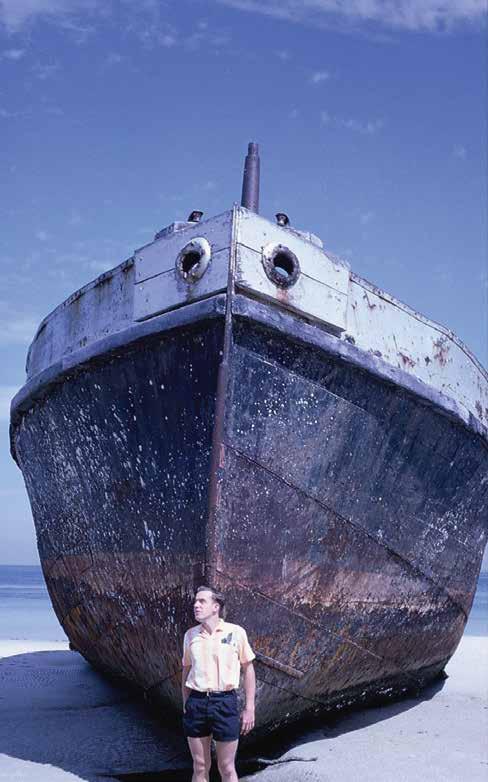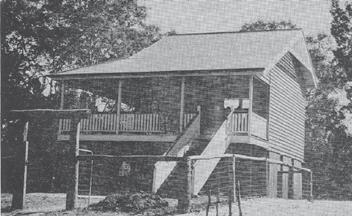
9 minute read
History
A FEW FIRSTS & FACTS
Bribie Boats, Birds and Buildings
Advertisement
This article provides a few historical firsts and facts about a range of people, places and things that people ask me about. Some of these things you may know, but others may surprise you and your friends.
BIRDS
There are over 9,000 different species of birds in the world, of which more than 850 can be seen in Australia at various times of the year. About 40% of them are specific to Australia and found nowhere else on earth. Bribie Island and Pumicestone Passage is home to about half of all the bird species in Australia, making it a uniquely important destination and environment. One-third of Australian shorebirds are year-round residents, and the other two-thirds are migratory. Most travel huge distances from their breeding grounds in the northern hemisphere, involving a return journey of a massive 30,000 kilometres. Some birds fly for several days non-stop to land in Pumicestone Passage, making it one of the most important bird and marine habitats on the east coast of Australia. Until a few years ago, I had the pleasure of seeing “Eric” the Emu regularly wander through my front garden at Banksia Beach. I wonder if there are still any Emu on Bribie Island. There is a couple of great location to observe Bribie birds at the Kakadu Bird Hide, Banksia Beach, and Buckley’s Hole bird hide at Bongaree. About 40 years ago, this important site was threatened by a proposal to build a large Boat Marina at Red Beach near Buckley’s Hole. Here is a picture of the Marina proposal, which was fortunately rejected by the Council at the time.
SHIP WRECKS.
There have been a few notable shipwrecks and deliberate sinking’s on Bribie Island over the years. The Steamship “Eastern” ran aground 111 years ago on a Reef at the southern end of Bribie Island in 1911. After many unsuccessful attempts to re-float the laden ship, the cargo of rice, canned foods, petrol, shark oil and peanuts, was thrown overboard and washed up on Woorim beach. Custom Officers rode along the beach on bicycles trying to destroy the cargo. Charles
Barry Clark Bribie Island Historical Society
Godwin, after whom Godwin Beach is named, was engaged to collect the salvaged goods and take them to Brisbane on his boat. Returning from the second trip, Charles. Godwin was knocked overboard by a sail and drowned. In 1915, an old paddle wheeler coal hulk “Avon” was deliberately scuttled in Pumicestone Passage, opposite Dux Creek, to protect oyster banks. It has now almost completely rusted away after 107 years but is still visible at low tide, and Avon Avenue at Banksia Beach was named for it. Over the years there has been considerable erosion of beaches and sand dunes along Rickman Parade, Woorim, and South Esplanade, Bongaree in the 1930s there were three large sand dunes between the Surf Club and high tide. In 1958, a resident of South Esplanade decided to create his own protective groin and purchased the hulk of a large old metal cargo vessel named “Cormorant”. He arranged for it to be towed from Brisbane, and on arrival to be placed on the beach at South Esplanade and a hole to be blown in the hull, to sink it in location. It was actually scuttled in a slightly different location than intended, but it served as effective protection against sand migration for 32 years until it was too rusty and dangerous and was removed by Council in 1990. Over those 32 years many thousands of children, and many readers of this article, will remember playing on it.

ORIGINAL RESIDENTS
Early explorers in the 1840s described their first encounter with residents of this island as very fine-looking people, tall, wild, hardy and fierce. By the 1860’s they had a reputation for resistance and hostility to European settlement and the native police were directed to “disperse” them. By the 1870s there were
very few left and a Government reserve was set up at Whitepatch in 1877 for the few remaining Ngunda people of the area. They were provided with some rations, fishing nets and a boat, but it closed in less than 2 years. In 1891, an aboriginal mission and school were established at Mission Point, but it also closed and the children transferred to North Stradbroke Island. The children included two of the six children of Kal-Ma-Kuta, and her white husband Fred Turner, who had married in 1872. When she died in 1897 she was the last Joondoburri woman of Bribie Island, and her memorial cairn still stands in the central reserve of the Bribie Island road, close to Turners Camp where they lived.
CHURCHES
Methodists purchased a block of land in Banya Street, Bongaree, in April 1924 and brought the old State School from Narangba, and relocated it to Bribie Island. The old wooden building had been relocated several times, originally as a Church in Enogerra in the 1880s and a School at Deception Bay in the 1900s. The first Church service ever held in a church on Bribie Island was in this building in Banya Street on 23rd December 1928. Prior to that, open-air services were held under a big gum tree where Bribie Bowls Club now stands. The Church of England, also in Banya Street, had its first service just a few days later, in a new large wooden hall that was both a church and community hall facility, including a Cinema on Saturday nights. The original Cooinda hall is still in use today, and a new Anglican Church was built beside it. The Methodists continued in the old wooden building until they merged to become the Uniting Church and moved to a new Church in Webster Street. In 1986 they sold the old wooden church to become the Lodge for the newly formed Bribie Freemasons. This is by far the oldest building on Bribie, having been constructed over 140 years ago, although only on Bribie for 98 of those years. With the rapidly declining number of Bribie Freemasons, will the old building still be around to celebrate its Centenary on Bribie in 2024. The Bribie Baptist church in Cotterill Avenue was built back in 1962 as a skating rink and dance Hall, before becoming a Cinema for a decade and then Busy Fingers for over 20 years until they relocated further up the Avenue. The Baptists are soon to build a big new Church in the bush along First Avenue. What will happen then to that interesting old building? The first Catholic Church was an old wooden Hut brought down from Fort Bribie military Camp at the north of the island after the war in 1947 and placed on the corner of First Avenue and Nulu Street, Bongaree. This was a gift from the Coward family in memory of their only son Charles, killed in action in 1943, and was officially opened on New Year’s Day 1948. In 1964, a new Catholic church was constructed across the road, next to the State Primary School, and is the most easterly Catholic Church in Australia. In 1973, the Caboolture Shire Council invited various religious bodies for an expression of interest in setting up a retirement village on land at Bongaree. There was little interest other than from the Queensland Churches of Christ, who opted to construct the first retirement units in Foley Street. The first religious service was conducted in the Lounge in May 1976, and the Retirement Village complex was officially opened in June of that year. A Church was built on the land in 1986 and since then many more independent Units and a Nursing Home have been constructed.
BANKS

The ANZ. Bank established the first Bank agency at Bongaree in 1946, and the first permanent Bank opened in First Avenue Bongaree, in 1977. In the 1960s, CBA. established an agency on Bribie Island in Joe Di Bettas Café beside the Jetty. After several moves, a CBA Branch was set up in the Co-op Store at Bongaree in 1972. Westpac Bank, being a merger of Bank NSW and CBA. established a branch in 1983in Toorbul Street, Bongaree. The way things are going now, we may not have many Banks at all on Bribie in a few years.
SCHOOLS

In February 1924 the Bribie Island Provisional School opened, and in the next year there were 26 students enrolled, some of whom travelled daily from up the Pumicestone Passage and Toorbul Point During the first year, 72 children were enrolled and 41 left. The children of pioneer families at the school included McDonald, Shirley, Ormiston, Creber, Bestman, Campbell and Landers. Some of their descendants still live on Bribie Island. The School was closed between April 1942 and March 1943 at the height of the WW2 military occupation of the Island. The new State High School opened in 1989, a second Primary School opened at Banksia Beach in 1992 with all modern amenities.
WATER SUPPLY
The Governor of Queensland turned on the Bribie Island Water Supply in November 1961, and as part of the opening spectacle, three jets of water spiralled to a height of almost 10 meters. The initial system had two water storage towers, one at Bongaree, another at Woorim, and 25 years later in 1986, a third was constructed at Bellara. Each Tower was 30 meters high and stored 30,000 gallons. The water came from underground bores sunk 10 meters below the sand of Bribie Island. Apart from personal bores, all Bribie water now comes by pipeline from the mainland.
BOWLS
Members of Windsor Bowls Club in Brisbane were frequent visitors on the steamship Koopa to Bribie Island in 1928. These included Bell, Winston, Warren and McDonald who discussed forming a Bowls Club on Bribie. Tug Company director G.P Campbell offered to build a four rink green and a Club House for 30 shillings ($3) per week rent. The first Club House had been brought over from Stradbroke Island and initially used as a dance hall and school, on the hill where the water tower now stands. When the new State School opened in 1924, the old wooden hall was moved down the hill to become the original Bowls Club House. In 1930, the greens were increased to seven rinks, and there were 85 members including 4 ladies, and the small Bar comprised an 'ice chest' for bottle beer, with ice brought from Redcliffe on the Steamship Koopa.
A HERITAGE WALK
If you enjoyed reading this, you might like to come on a guided Heritage Walk with me around Bongaree. The walks I am conducting in the next couple of months are free, and will be on Thursday March 3rd and May 5th. They are a gentle stroll around the streets of Bongaree for about 90 minutes, to hear the fascinating history of many familiar buildings. Numbers are limited and Bookings are essential, so look for Bongaree Heritage walk on web site mbrc.qld.gov.au/healthyactive and book your free ticket.
MORE BRIBIE HISTORY
The next Historical Society meeting will be on Wednesday 9th March at 6;30 pm at the RSL Club. We have excellent guest speakers and visitors are welcome, subject to advice.. View much more on our new Web Site Bribiehistoricalsociety.org.au our Blog Site http://bribieislandhistory. blogspot.com or contact us on bribiehistoricalsociety@gmail.com






